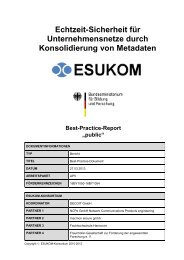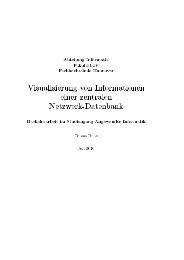Leveraging Trusted Network Connect for Secure ... - esukom
Leveraging Trusted Network Connect for Secure ... - esukom
Leveraging Trusted Network Connect for Secure ... - esukom
Create successful ePaper yourself
Turn your PDF publications into a flip-book with our unique Google optimized e-Paper software.
centralized management required <strong>for</strong> a broader and secure adoption of<br />
smartphones as endpoints in enterprise network infrastructures.<br />
b. Open and ubiquitous nature of mobile endpoints: the growing popularity<br />
of smartphones is attracting more and more enterprises to deploy them as<br />
integrated components of their enterprise network. Designed as open and<br />
programmable-networked embedded devices, smartphones are used by<br />
mobile and external employees to access and manage critical business data in<br />
a ubiquitous way (see section 2.1). This fact has introduced new technologies<br />
and new security challenges to the urgent need <strong>for</strong> machine-to-machine<br />
identification and authentication, and cross-layer network access<br />
authorization. Machine level plat<strong>for</strong>m-authentication is crucial <strong>for</strong> the<br />
security and authorization of network-access requests at both layer-2 and<br />
layer-3. Furthermore, due to recent attacks at the higher layers (e.g.<br />
attributable to the increasing number of smartphones malwares) a major<br />
problem that needs to be addressed is that of achieving integrity of mobile<br />
endpoints. The problem of endpoint integrity concerns in our case the<br />
trustworthiness of the smartphones and that of enterprise servers with regard<br />
to their respective integrity states, including their identities. By the term<br />
integrity, we understand relative purity of the smartphone plat<strong>for</strong>m from<br />
software (and hardware) that are considered harmful to the phone itself and<br />
others with whom it interacts. The growing number of smartphone malwares<br />
best exemplifies this problem <strong>for</strong> corporate networks. As illustrated in the<br />
motivation scenario, today employees connect their mobile devices to<br />
unsecured networks, at home or when they are away on business, often<br />
resulting in malware being inadvertently downloaded onto the smartphone.<br />
When (re-) connected to the corporate network, the device becomes a<br />
distributor of the malware to other devices on the enterprise network. [2]<br />
2.3 Security requirements<br />
For the a<strong>for</strong>ementioned scenario and with regard to the security risks and challenges<br />
described above, we define the following requirements:<br />
a. Backward compatibility and scalability: it is not reasonable to build an<br />
entirely new NAC solution that does not interwork with already existing<br />
solutions, industry standards and open specifications. There<strong>for</strong>e, proposals<br />
<strong>for</strong> a new NAC system have to be interoperable systems leveraging a number<br />
of existing and emerging standards, products, or techniques such as IEEE<br />
802.1X and/or others. Moreover, a new NAC system should provides<br />
features required to guarantee good scalability and per<strong>for</strong>mance especially<br />
<strong>for</strong> large-scale enterprise environments, e.g. centralized configuration and<br />
policy management. The complexity of maintaining such a deployed NAC<br />
system should be reasonable.<br />
b. Enterprise’s network security policy should be reliably en<strong>for</strong>ced:<br />
additionally to user and device credentials, the mobile endpoint’s state of<br />
health and security should be considered <strong>for</strong> validation during the access





